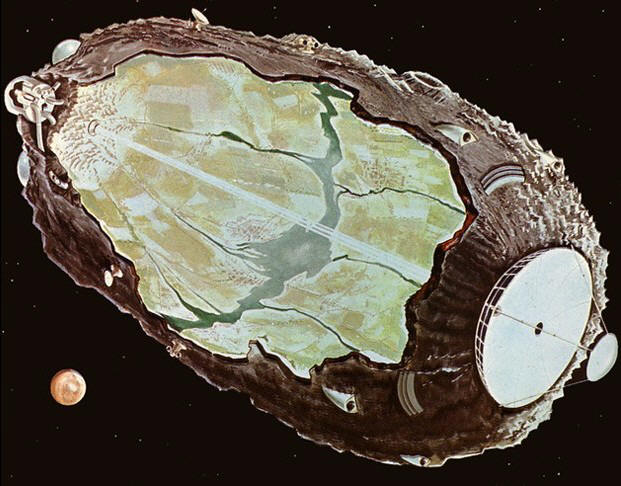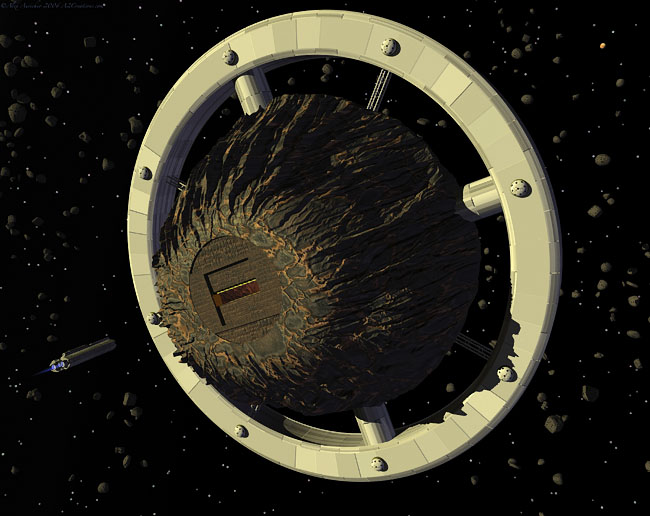 | | A Cutaway View Of A Business Agricultural Skyhook; The Beam Down The Center Ensures The Plants Grow. |
|---|
 | | A Shipyard-Type Skyhook. |
|---|
"Skyhooks" are structures that float above the surface of a planet, usually outside it's atmosphere and tethered to the surface below; These are often used to transport material to and from a planet's surface into orbit, continuously supporting it rather than using rockets, catapults or gravpods. In many cases, they are also symbols of status among the very wealthy. The term was coined by scientist Giuseppe COLOMBO.HistoryUnder the UGC skyhooks were at one point banned due to the possibility of system failures which would send them crashing into the planet. This ban was later dropped. However, during a battle in the Rakatan Galaxy, a malcontent Warship deliberately targeted a Skyhook to cause it to crash to the planet, exactly as feared. After that new regulations were enacted to ensure this would not likely happen again; Firstly that they had to have emergency breakaway power (in other words, rockets to break away from a planet if necessary). Another regulatory change was that the Skyhooks were to be kept at higher orbit, but low enough not to interfere with the Lagrange 4 and 5 points. The Lagrange 1 point (where the gravities of the moon and planet equalize in a straight line of each other) is generally preferred, though individual systems are at their liberty to make exact determinations.TypesThere are 04 major types; Industrial, Commercial, Residential, and Office. Most are two or more, with the most common combinations being percentages of industrial, commercial, and residential in the so-called 25/65/10 configuration; The industrial facilities (roughly 65% of the skyhook) produce whatever is requested through the commercial operation (roughly 25%). Employees of the skyhook live onboard in the limited residential facilities (roughly 10% of the station). Most keep some accommodations available for clientele who are forced to stay for more than one day.Another popular variant is the 10/60/30; 10% commercial, 60% office, and 30% residential. These tend to have nicer appointments than the 25/65/10's, even with recreational facilities (such as casinos and nightclubs).And of course is the crème d' la crème, the opulent Palatial type. These are the private homes of very wealthy, powerful persons. The only people seen on these skyhooks are the owners, the workers (often kept in very cramped quarters; though much higher paid, the conditions are usually worse than the 25/65/10's), and the occasional guests of the owners. These skyhooks often have macroenvironments maintained by the facilities machinery; The rain is fake, but feels terribly good.ConstructionSkyhooks are actually asteroids that have been captured into geostationary orbit, then typically hollowed out over time. These are typically mining operations to support the industry of the planet below, though so-called expanded skyhooks (where 2 or more asteroids are brought together into one) are often paid out mining operations that have been retrofitted to supporting space industry (de facto shipyards). Because no two asteroids are the same, no two skyhooks can be the same, and as such no stats are given for these stations; However, the smallest to date recorded is the 20-mile wide Sanjee Industries #46 which was converted to commercial/residential when the mining operations payed out; The largest is the 2,000 mile Norkele Central. Any smaller than Sanjee Four Six and the shell typically can't support itself (in point of fact, Sanjee Four Six is supported by iron girders, whereas most skyhooks are not). Any larger, and the same problem arises, as the gravitational effects of the shell itself is no longer self-supporting (Norkele pushes this to the absolute limits, and the Patrol has advised the company to shut the facility down and implode the remains).It is worthy to note that the First of the Tiresian "space factories" were in fact little more than skyhooks themselves of the shipyard/industrial variety, with later development influencing design. |